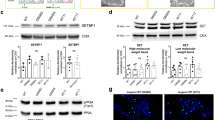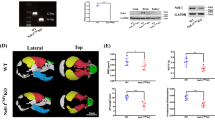Abstract
Treacher Collins syndrome (TCS) is a congenital disorder of craniofacial development arising from mutations in TCOF1, which encodes the nucleolar phosphoprotein Treacle. Haploinsufficiency of Tcof1 perturbs mature ribosome biogenesis, resulting in stabilization of p53 and the cyclin G1–mediated cell-cycle arrest that underpins the specificity of neuroepithelial apoptosis and neural crest cell hypoplasia characteristic of TCS. Here we show that inhibition of p53 prevents cyclin G1–driven apoptotic elimination of neural crest cells while rescuing the craniofacial abnormalities associated with mutations in Tcof1 and extending life span. These improvements, however, occur independently of the effects on ribosome biogenesis; thus suggesting that it is p53-dependent neuroepithelial apoptosis that is the primary mechanism underlying the pathogenesis of TCS. Our work further implies that neuroepithelial and neural crest cells are particularly sensitive to cellular stress during embryogenesis and that suppression of p53 function provides an attractive avenue for possible clinical prevention of TCS craniofacial birth defects and possibly those of other neurocristopathies.
This is a preview of subscription content, access via your institution
Access options
Subscribe to this journal
Receive 12 print issues and online access
$209.00 per year
only $17.42 per issue
Buy this article
- Purchase on Springer Link
- Instant access to full article PDF
Prices may be subject to local taxes which are calculated during checkout






Similar content being viewed by others
Accession codes
References
Phelps, P.D., Poswillo, D. & Lloyd, G.A. The ear deformities in mandibulofacial dysostosis (Treacher Collins syndrome). Clin. Otolaryngol. 6, 15–28 (1981).
Rovin, S., Dachi, S.F., Borenstein, D.B. & Cotter, W.B. Mandibulofacial dysostosis, a familial study of five generations. J. Pediatr. 65, 215–221 (1964).
Fazen, L.E., Elmore, J. & Nadler, H.L. Mandibulo-facial dysostosis. (Treacher-Collins syndrome). Am. J. Dis. Child. 113, 405–410 (1967).
Edwards, S.J., Gladwin, A.J. & Dixon, M.J. The mutational spectrum in Treacher Collins syndrome reveals a predominance of mutations that create a premature-termination codon. Am. J. Hum. Genet. 60, 515–524 (1997).
Gladwin, A.J. et al. Treacher Collins syndrome may result from insertions, deletions or splicing mutations, which introduce a termination codon into the gene. Hum. Mol. Genet. 5, 1533–1538 (1996).
The Treacher Collins Syndrome Collaborative Group. Positional cloning of a gene involved in the pathogenesis of Treacher Collins syndrome. Nat. Genet. 12, 130–136 (1996).
Wise, C.A. et al. TCOF1 gene encodes a putative nucleolar phosphoprotein that exhibits mutations in Treacher Collins Syndrome throughout its coding region. Proc. Natl. Acad. Sci. USA 94, 3110–3115 (1997).
Meier, U.T. & Blobel, G. Nopp140 shuttles on tracks between nucleolus and cytoplasm. Cell 70, 127–138 (1992).
Valdez, B.C., Henning, D., So, R.B., Dixon, J. & Dixon, M.J. The Treacher Collins syndrome (TCOF1) gene product is involved in ribosomal DNA gene transcription by interacting with upstream binding factor. Proc. Natl. Acad. Sci. USA 101, 10709–10714 (2004).
Hayano, T. et al. Proteomic analysis of human Nop56p-associated pre-ribosomal ribonucleoprotein complexes. Possible link between Nop56p and the nucleolar protein treacle responsible for Treacher Collins syndrome. J. Biol. Chem. 278, 34309–34319 (2003).
Dixon, J. et al. Tcof1/Treacle is required for neural crest cell formation and proliferation deficiencies that cause craniofacial abnormalities. Proc. Natl. Acad. Sci. USA 103, 13403–13408 (2006).
Zhao, L. et al. Cyclin G1 has growth inhibitory activity linked to the ARF-Mdm2-p53 and pRb tumor suppressor pathways. Mol. Cancer Res. 1, 195–206 (2003).
Tomasini, R. et al. TP53INP1s and homeodomain-interacting protein kinase-2 (HIPK2) are partners in regulating p53 activity. J. Biol. Chem. 278, 37722–37729 (2003).
Aleo, E., Henderson, C.J., Fontanini, A., Solazzo, B. & Brancolini, C. Identification of new compounds that trigger apoptosome-independent caspase activation and apoptosis. Cancer Res. 66, 9235–9244 (2006).
Reczek, E.E., Flores, E.R., Tsay, A.S., Attardi, L.D. & Jacks, T. Multiple response elements and differential p53 binding control Perp expression during apoptosis. Mol. Cancer Res. 1, 1048–1057 (2003).
Mendez-Vidal, C., Wilhelm, M.T., Hellborg, F., Qian, W. & Wiman, K.G. The p53-induced mouse zinc finger protein wig-1 binds double-stranded RNA with high affinity. Nucleic Acids Res. 30, 1991–1996 (2002).
Levine, A.J. p53, the cellular gatekeeper for growth and division. Cell 88, 323–331 (1997).
Zaika, A., Marchenko, N. & Moll, U.M. Cytoplasmically 'sequestered' wild type p53 protein is resistant to Mdm2-mediated degradation. J. Biol. Chem. 274, 27474–27480 (1999).
Burstyn-Cohen, T. & Kalcheim, C. Association between the cell cycle and neural crest delamination through specific regulation of G1/S transition. Dev. Cell 3, 383–395 (2002).
Komarov, P.G. et al. A chemical inhibitor of p53 that protects mice from the side effects of cancer therapy. Science 285, 1733–1737 (1999).
Zhai, W. & Comai, L. Repression of RNA polymerase I transcription by the tumor suppressor p53. Mol. Cell. Biol. 20, 5930–5938 (2000).
Donehower, L.A. et al. Mice deficient for p53 are developmentally normal but susceptible to spontaneous tumours. Nature 356, 215–221 (1992).
Ihrie, R.A. et al. Perp is a p63-regulated gene essential for epithelial integrity. Cell 120, 843–856 (2005).
Jensen, M.R. et al. Reduced hepatic tumor incidence in cyclin G1–deficient mice. Hepatology 37, 862–870 (2003).
Kimura, S.H. & Nojima, H. Cyclin G1 associates with MDM2 and regulates accumulation and degradation of p53 protein. Genes Cells 7, 869–880 (2002).
Dixon, J., Brakebusch, C., Fassler, R. & Dixon, M.J. Increased levels of apoptosis in the prefusion neural folds underlie the craniofacial disorder, Treacher Collins syndrome. Hum. Mol. Genet. 9, 1473–1480 (2000).
Nonn, L., Williams, R.R., Erickson, R.P. & Powis, G. The absence of mitochondrial thioredoxin 2 causes massive apoptosis, exencephaly, and early embryonic lethality in homozygous mice. Mol. Cell. Biol. 23, 916–922 (2003).
Pani, L., Horal, M. & Loeken, M.R. Rescue of neural tube defects in Pax-3–deficient embryos by p53 loss of function: implications for Pax-3–dependent development and tumorigenesis. Genes Dev. 16, 676–680 (2002).
Ruggero, D. & Pandolfi, P.P. Does the ribosome translate cancer? Nat. Rev. Cancer 3, 179–192 (2003).
Garcia-Cao, I. et al. “Super p53” mice exhibit enhanced DNA damage response, are tumor resistant and age normally. EMBO J. 21, 6225–6235 (2002).
Kaufman, M.H . The Atlas of Mouse Development, 507 (Academic Press, London, 1992).
Nagy, A., Gertsenstein, M., Vintersten, K. & Behringer, R.R. Manipulating the Mouse Embryo, Ch.16 (Cold Spring Harbor Laboratory, Cold Spring Harbor, 2003).
Wilson, C.L. & Miller, C.J. Simpleaffy: a BioConductor package for Affymetrix Quality Control and data analysis. Bioinformatics 21, 3683–3685 (2005).
R Development Core Team. A language and environment for statistical computing. The R Project for Statistical Computing. <http://www.R-project.org> (2006).
Livak, K.J. & Schmittgen, T.D. Analysis of relative gene expression data using real-time quantitative PCR and the 2-ΔΔCT method. Methods 25, 402–408 (2001).
Krull, C.E. A primer on using in ovo electroporation to analyze gene function. Dev. Dyn. 229, 433–439 (2004).
Horne, M.C. et al. Cyclin G1 and cyclin G2 comprise a new family of cyclins with contrasting tissue-specific and cell cycle-regulated expression. J. Biol. Chem. 271, 6050–6061 (1996).
Acknowledgements
We thank the Trainor and Dixon groups for comments on the manuscript; R. McCay and M. Morgan for maintenance of mutant mouse lines and administration of pifithrin-α; T. Yao and J. Ren for technical assistance with protein analysis and p53 antibody activity; D. Stark for confocal imaging expertise; S. Das for the Ccng1 riboprobe, D. Quelle and M. Horne for Ccng1 expression vectors; and E. Rubel for the Y10b antibody. Research in the Trainor laboratory is supported by the Stowers Institute for Medical Research, March of Dimes (6FY05-82), National Institute of Dental and Craniofacial Research (RO1 DE 016082-01) and the Hudson Foundation. Research in the Dixon laboratory is supported by the National Institutes of Health (P50 DE 016215) and the Medical Research Council, UK (G81/535).
Author information
Authors and Affiliations
Contributions
N.C.J., J.D., M.J.D. and P.A.T. conceived and designed the project and wrote the manuscript. N.C.J., M.L.L. and L.E. performed embryonic skeletal and adult analyses; N.C.J., K.G. and E.F.G. performed microarray and quantitative PCR analyses; N.C.J., M.L.L. and P.A.T. performed in situ hybridization and TUNEL staining; N.C.J., D.S., K.A. and J.-P.R. performed immunohistochemistry; D.S. performed electroporation and C.D., J.D. and M.J.D. provided knockout mice and other reagents.
Corresponding author
Supplementary information
Supplementary Text and Figures
Supplementary Table 1 and Supplementary Figs. 1–7 (PDF 581 kb)
Rights and permissions
About this article
Cite this article
Jones, N., Lynn, M., Gaudenz, K. et al. Prevention of the neurocristopathy Treacher Collins syndrome through inhibition of p53 function. Nat Med 14, 125–133 (2008). https://doi.org/10.1038/nm1725
Received:
Accepted:
Published:
Issue Date:
DOI: https://doi.org/10.1038/nm1725
This article is cited by
-
Tcof1 haploinsufficiency promotes early T cell precursor-like leukemia in NrasQ61R/+ mice
Leukemia (2022)
-
TCOF1 upregulation in triple-negative breast cancer promotes stemness and tumour growth and correlates with poor prognosis
British Journal of Cancer (2022)
-
TRF2 recruits nucleolar protein TCOF1 to coordinate telomere transcription and replication
Cell Death & Differentiation (2021)
-
Tracking the movement of individual avian neural crest cells in vitro
In Vitro Cellular & Developmental Biology - Animal (2021)
-
The regulatory roles of p53 in cardiovascular health and disease
Cellular and Molecular Life Sciences (2021)



